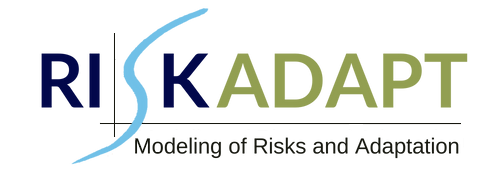
Pilot 1 (Greece)
The Landmark Polyfytos Road Bridge in Greece is an asset of the Region of Western Macedonia. The bridge is a long curved prestressed reinforced concrete structure that provides crucial connections between the cities of Kozani and Athens and is used for the daily transfer of people and goods between the busy local communities and towns. Moreover, it is a vital structure for the natural ecosystem. In RISKADAPT, the University of Birmingham assesses probabilistically the present structural condition of the bridge using advanced measurement methods and data (including InSAR and UAV-enabled photogrammetry) in order to update an existing UAV-based point cloud into a digital twin of the asset. The future condition of the bridge will be also assessed by taking into account material deterioration, with particular focus on the reclining cantilevers of the long spans and the specified hydrodynamic loads. Furthermore, the most promising structural adaptation measures will be evaluated in terms of the provided safety, emissions, construction rapidity and cost, while duration and state of the asset during structural adaptation will be used to derive the corresponding bridge functionality and the resulting social costs.
Pilot 2 (Finland)
The second pilot in RISKADAPT project focuses on the vulnerability of energy transmission grid in a Nordic climate. In specific, Fingrid, which is the company responsible for the power transmission in Finland, provides a typical configuration of a power transmission line and corresponding transmission tower models that are used in Finland, which as a Nordic country is characterized by adverse winter conditions with large amounts of snow and ice accretion on the exposed members of structures. ERRA performs the probabilistic structural analyses of the towers against wind and icing loadings. Based on the structural analyses, the vulnerability of the transmission line due to extreme weather conditions is estimated taking also into account the output provided by FMI on the severity and timing of high winds combined also with icing. Furthermore, the use of adaptation options, such as use of High Strength Steel (HSS) and FRP stripes will be investigated. Similarly to pilot 1, the BIM system will estimate embodied emissions and costs of the adaptation solutions, while the engineering and social risks and impacts will be evaluated by the RISKADAPT integrated platform and the Model Information System. Finally in this pilot, FMI studies the CC impacts for extreme icing and wind conditions on corona discharge losses in electricity transmission.


Pilot 3 (Italy)
Pilot 3 examines a high-rise hospital building located in Trieste, Italy. Hospital Cattinara was founded in 1984 and has a capacity of 565 bends. The hospital’s facilities include two 15-storey towers. The city of Trieste is located on the Adriatic Sea and is surrounded by the Carsic hills that make the city particularly exposed to the Bora wind, which is an intense phenomenon characterised by sudden strong gusts that can reach 130-150 km/h. Therefore, especially tall buildings such as the hospital’s towers are extremely vulnerable to high wind and wind driven rain. For this pilot, TECNIC performs deterministic assessments for the present and future structural condition of the buildings in order to determine the safety factors and damage. Furthermore, the analyses are expanded in order to evaluate any additional structural resistance provided by the most promising adaptation solutions. In a second phase, the deterministic solutions are transformed into probabilistic ones by RISA. As in the case of the first two pilots, BIM system estimates embodied emissions and costs of the adaptation solutions, while the RISKADAPT integrated platform along with the Model Information System are used to evaluate the engineering and social impacts and risks.
Pilot 4 (Hong Kong)
The fourth pilot of RISKADAPT refers to Hong Kong area. Hong Kong constitutes a very densely populated area including many high-rise buildings with glass facades. The area, and especially its tall buildings, are extremely vulnerable to high winds and wind-driven rain due to tropical cyclones. For this pilot, the University of Hong Kong, in collaboration with the University of Bologna, elaborates both computational fluid dynamics and wind tunnel modelling for building clusters with a history of glass window damage due to past typhoons. The analyses will produce algorithms that can determine glass window damage incorporating results of past typhoons and taking also into account parameters such as building layout and wind dynamics. Furthermore, as in the case of the rest of RISKADAPT pilots, possible adaptation solutions will be identified.

